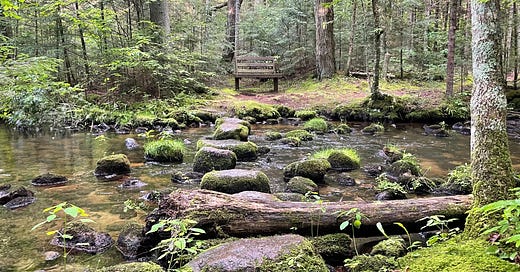If you live in the Midwest and enjoy outdoor recreation, you have almost certainly heard some variation of the following from an acquaintance justifying why they don’t venture into nature:
“There’s nowhere good to hike nearby.”
“If I lived near the mountains, I would be outside all the time.”
“All the state parks are flat, so why bother driving there when I can just walk on a sidewalk at home.”
I got so sick of hearing these refrains that my pandemic project became creating a 100+ page Google Doc where I organized a list of places to hike, camp, and backpack by state and driving distance from Chicago. We may not have mountaintop vistas, but there’s tons of beauty in the Midwest—flowering prairie plants that grow taller than your head in August, waterfalls of all heights and widths, and even some remaining pockets of old growth forest.
Hiking in the Midwest doesn’t inspire me to become a photographer (though I take a lot of photos) nor to hike as many miles as possible (though I am working towards section hiking the entire Ice Age Trail). Hiking in the Midwest inspires me to crouch down for a better look at fungi, to listen to water slowly eroding river rocks, to breathe in familiar scents that I can’t quite name. It inspires me to become a naturalist.
One of my great joys on trail is to see a plant or hear a bird call and know what it is without needing to consult an identification app or guidebook. Sometimes it’s easy to learn something new, like the shagbark hickory which immediately makes me think, “That bark is pretty shaggy!” or ghost pipe which is a ghostly white color since it does not produce chlorophyll. But most of the time I’m not great at pulling names from the recesses of my brain, so I rely on my apps.
Have you ever stumbled across a group of hikers standing silently in the middle of the trail with a phone raised above their head? They are probably using the Merlin app to listen for and identify bird songs. How about a person who is slowly scanning the leaves and flowers of a plant that’s only three inches away from them? I bet they are trying to find the right angle for the Seek app to confirm a species.
Unfortunately, I haven’t found a rock identification app that I like yet, so when I come across an interesting one, I just run my fingers across it and say, “That’s a nice rock!” The exception is if it is rotten granite, in which case I’ll say, “That would make some nice crush!”1
There’s a slightly giddy feeling when I discover new-to-me flora or fauna, like I’ve uncovered some secret of the trail. Noticing takes effort, patience, and a bit of luck. I think that’s why Midwestern hiking gets a bad rap. If you hike in the Grand Canyon, you can’t miss the canyon. If you hike in Glacier, you can’t miss the mountains. If you don’t know what to look for in the Midwest, you might miss the eskers and the moss-covered erratics and the native orchids and then go home to tell all your friend that the nature here is boring.
It’s not boring. That’s a hill I will die on. And when I’m on that hill, you know I will have my apps open—listening for the birdsongs around me, scanning the leaves of a plant with a pretty flower, and sending photos of mossy rocks to my group chats.
Crush refers to rocks the size of golf balls and smaller that is used in stonework projects to help level and solidify steps and retaining walls. When building trail, it isn’t always feasible to haul in gravel, so you can make your own crush in the field by finding soft stones and then hammering them into the appropriate size with a two pound mini sledgehammer (or occasionally, a ten pound full sized sledgehammer).







I agree that the more you learn about the geology and species, the more interesting any hike will be.